Satellite-Based Analysis of Nutrient Dynamics in Northern South China Sea Marine Ranching Under the Combined Effects of Climate Warming and Anthropogenic Activities
Abstract
1. Introduction
2. Study Area and Data Resources
2.1. Study Area
2.2. Data Sources
3. Remote Sensing Quantitative Inversion
3.1. Selection and Optimization of Remote Sensing Data Sources
3.2. The Establishment of Inversion Algorithms
4. Results
4.1. Spatiotemporal Evolution of the Total Nitrogen-to-Total Phosphorus Ratio (NP)
4.2. Analysis of Key Driving Factors
5. Discussion
6. Conclusions
Author Contributions
Funding
Data Availability Statement
Acknowledgments
Conflicts of Interest
Appendix A
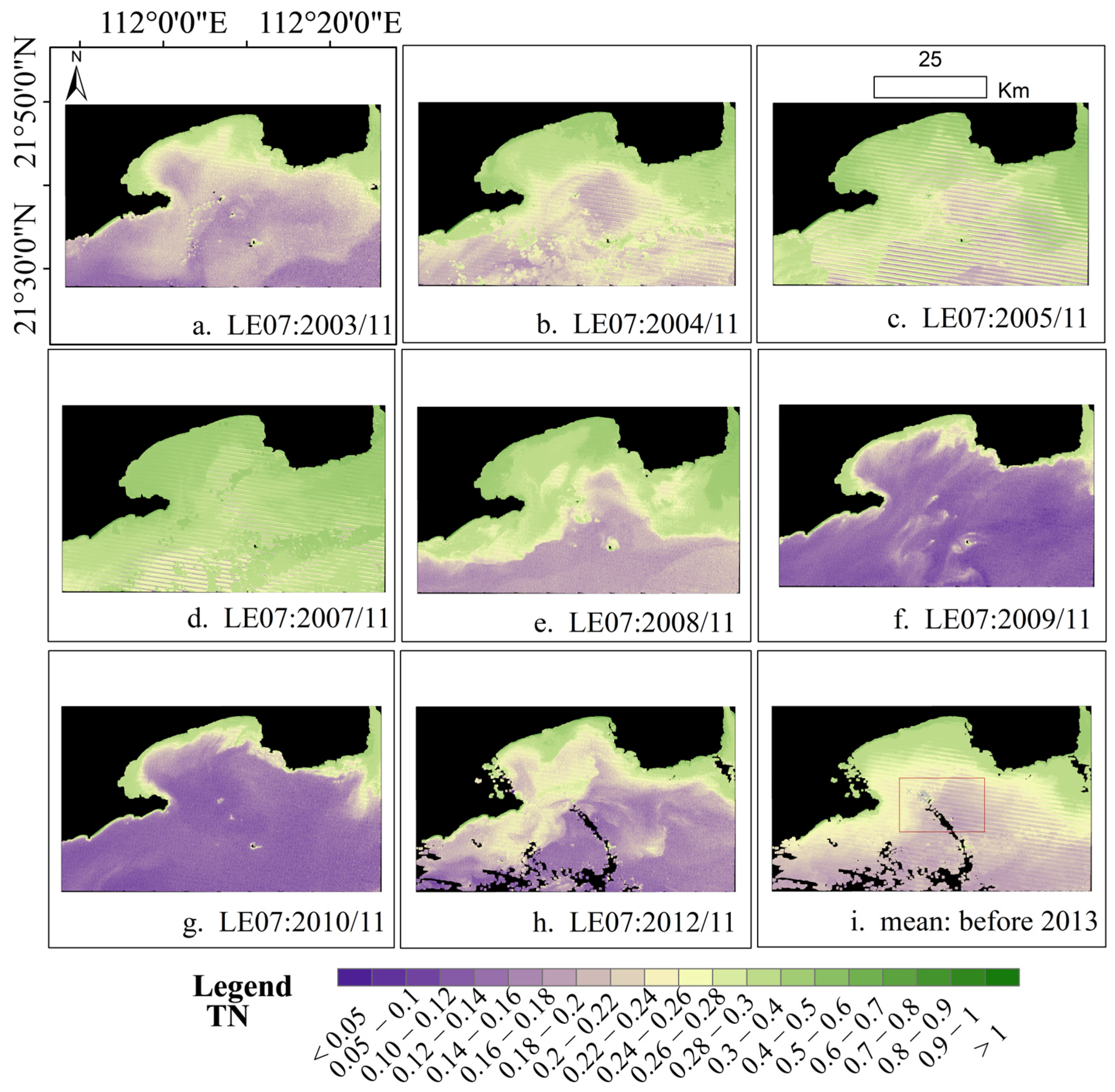

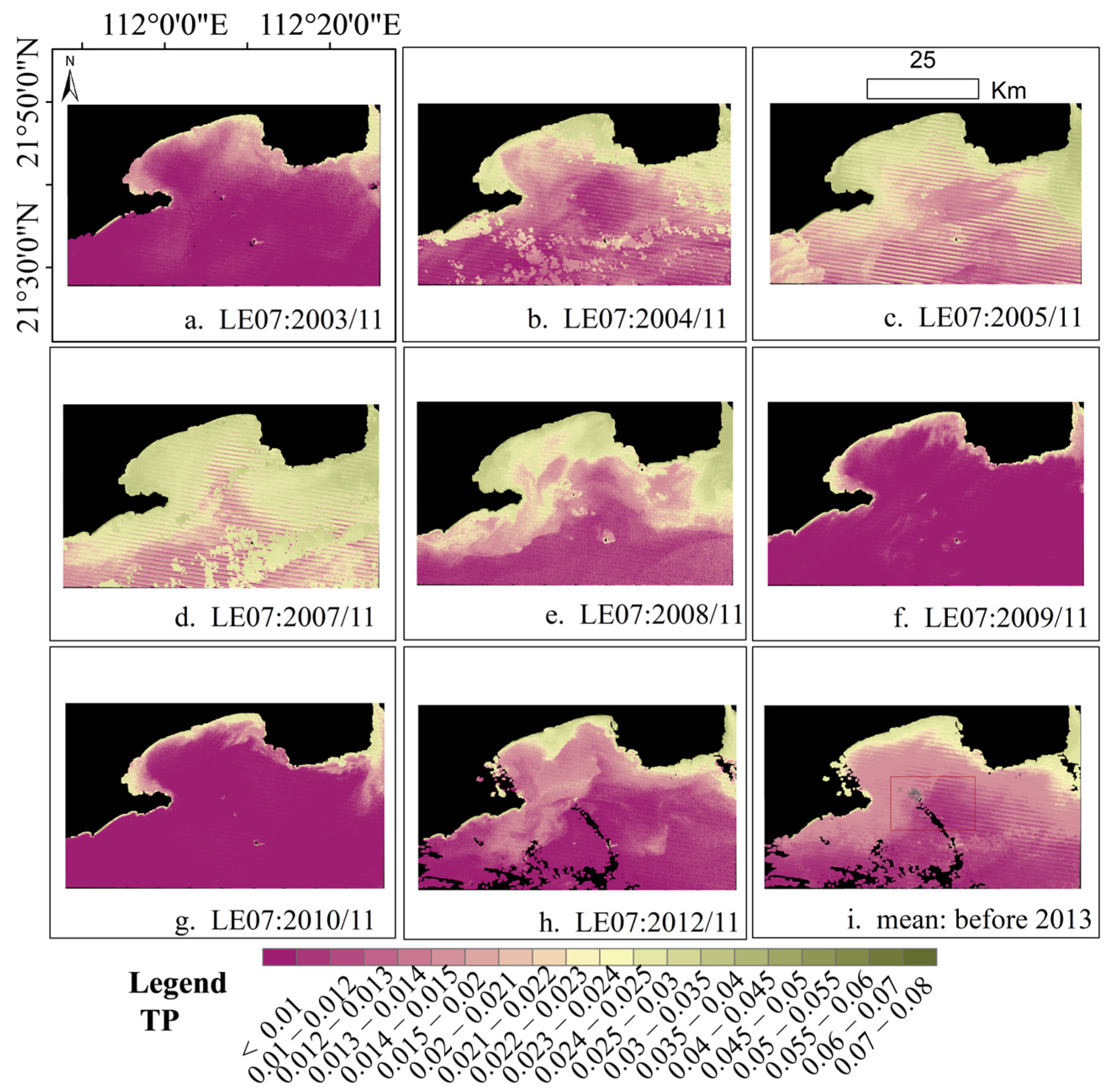
References
- Lin, M. Developing Large-Scale Deep Sea Aquaculture: Problems, Modes and Realization Ways. J. Manag. World 2022, 12, 39–60. [Google Scholar]
- Li, J. Marine Resource Economy and Marine Strategy under the Background of Marine Ecological Civilization Construction (Part 1). Ocean World 2022, 9, 58–67. [Google Scholar]
- Wang, X.; Zhang, M. China’s Marine Ranching Construction: Strategic Implications, Risks and Challenges, and Development Paths. Pac. J. 2024, 32, 67–80. [Google Scholar]
- Chen, Y. Research and construction of modern marine ranching in China: A review. J. Dalian Fish. Univ. 2020, 35, 147–154. [Google Scholar]
- Yang, H.; Ding, D. Marine Ranching Version 3.0: History, Status and Prospects. Bull. Chin. Acad. Sci. 2022, 6, 832–839. [Google Scholar]
- Zhou, W.; Jia, Z. Research on the Impact of the Construction of National Marine Ranching Demonstration Zones on the Resilience of Ecological Environment in Coastal Areas. Chin. Fish. Econ. 2025, 43, 27–41. [Google Scholar]
- Jiao, M.; Yue, W.; Suo, A.; Zhang, L.; Li, H.; Xu, P.; Ding, D. Construction and influencing factors of an early warning system for marine ranching ecological security: Experience from China’s coastal areas. J. Environ. Manag. 2023, 335, 117515. [Google Scholar] [CrossRef]
- He, W.; Ding, J.; Liu, W.; Zhong, W.; Zhu, L.; Zhu, L.; Feng, J. Occurrence, Bioaccumulation and Trophic Transfer of Organophosphate Esters in Marine Food Webs: Evidence from Three Bays in Bohai Sea, China. Sci. Total Environ. 2022, 828, 160658. [Google Scholar] [CrossRef] [PubMed]
- Sahu, B.; Pradhan, U.K.; Udayakrishnan, P.B.; Bambaras, P. Dissolved and suspended nutrient complexity in an urbanized creek-estuary confluence: Implication on water quality alteration. Mar. Pollut. Bull. 2024, 209 Pt B, 117259. [Google Scholar] [CrossRef]
- Yao, K.; Rui, Y.; Yang, W.; Feng, C.; Liu, Z. Distribution Characteristics of Nutrients and Eutrophication Assessment in Yueqing Bay. Ocean. Dev. Manag. 2024, 9, 121–132. [Google Scholar]
- Zhang, P.; Chen, Y.; Peng, C.; Dai, P.; Lai, J.; Zhao, L.; Zhang, J. Spatiotemporal Variation, Composition of DIN and Its Contribution to Eutrophication in Coastal Waters Adjacent to Hainan Island, China. Reg. Stud. Mar. Sci. 2020, 37, 101332. [Google Scholar] [CrossRef]
- Sala, B.; Giménez, J.; Fernández-Arribas, J.; Bravo, C.; Lloret-Lloret, E.; Esteban, A.; Bellido, J.M.; Coll, M.; Eljarrat, E. Organophosphate Ester Plasticizers in Edible Fish from the Mediterranean Sea: Marine Pollution and Human Exposure. Environ. Pollut. 2021, 277, 118377. [Google Scholar] [CrossRef] [PubMed]
- Olivero-Verbel, R.; Eljarrat, E.; Johnson-Restrepo, B. Organophosphate Ester Flame Retardants in Sediments and Marine Fish Species in Colombia: Occurrence, Distribution, and Implications for Human Risk Assessment. Mar. Pollut. Bull. 2025, 213, 117654. [Google Scholar] [CrossRef] [PubMed]
- Department of Natural Resources of Guangdong Province. Guangdong Marine Economy Development Report; Department of Natural Resources of Guangdong Province: Guangzhou, China, 2025. Available online: https://nr.gd.gov.cn (accessed on 15 July 2025).
- Wang, X.; Li, C.; Yi, N.; Zhang, H.; Liu, J.; Wang, X.; Liu, X. Investigation and Analysis of Water Quality and Environment of Shellfish Culture Area of Laizhou Bay, Shandong Province. J. Fish. Res. 2024, 3, 286–295. [Google Scholar]
- Redfield, A.C. The Influence of Organisms on the Composition of Seawater. In The Sea; Hill, M.N., Ed.; Interscience: New York, NY, USA, 1963; Volume 2, pp. 26–77. [Google Scholar]
- Xu, S.; Qi, Z.; Song, R.; Liu, Y.; Hu, T.; Huang, H. Influence of Mariculture on Tempo-Spatial Distribution of Nitrogen and Phosphorus in Subtropical Zone: A Case Study of Shen’ao Bay. South China Fish. Sci. 2019, 4, 29–38. [Google Scholar]
- Zhao, Y.; Sun, B.; Ma, Y.; Guo, W.; Xu, H.; Li, J.; Duan, X.; Sun, S. Characteristics of Nutrient Structures and Limitation of Coastal Aquaculture Area in Shandong Province, 2018. Mar. Environ. Sci. 2022, 5, 714–722, 730. [Google Scholar]
- Liu, J.; Wang, H.; Mou, J.; Peñuelas, J.; Delgado-Baquerizo, M.; Martiny, A.C.; Zhou, G.; Hutchins, D.A.; Inomura, K.; Lomas, M.W.; et al. Global-Scale Shifts in Marine Ecological Stoichiometry over the Past 50 Years. Nat. Geosci. 2025, 18, 769–778. [Google Scholar] [CrossRef]
- Zhang, N. Influence of External Source Nitrogen and Phosphate on Inorganic Carbon Source/Sink. Ph.D. Thesis, Institute of Oceanology, Chinese Academy of Sciences, Qingdao, China, 2008. [Google Scholar]
- Lin, Z.; Chen, H.; Liang, J. Temporal and Spatial Evolution Characteristics and Cause Analysis of Ratios of Nitrogen and Phosphorus in Offshore Waters of Guangdong Province. Guangdong Chem. Ind. 2022, 49, 141–144. [Google Scholar]
- Wang, Y.; Yu, J.; Chen, P. Remote Sensing Assessment of Ecological Effects of Marine Ranching in the Eastern Guangdong Waters, China. J. Geosci. Environ. Prot. 2018, 6, 101–113. [Google Scholar] [CrossRef]
- Wei, W.; Han, Y.; Zhou, Y. Nutrients and Sea Surface Temperature Drive Harmful Algal Blooms in China’s Coastal Waters over the Past Decades. Environ. Res. Lett. 2023, 18, 094068. [Google Scholar] [CrossRef]
- Chen, S.; Shi, L.; Liu, X.; Liu, R.; Yu, J. Evaluation on Sediment Pollution and Potential Ecological Risks in the Intertidal Zone of Typical Bays in Zhejiang Province. China Environ. Sci. 2020, 40, 1771–1781. [Google Scholar]
- Cai, W.J.; Hu, X.; Huang, W.J.; Murrell, M.C.; Lehrter, J.C.; Lohrenz, S.E.; Chou, W.C.; Zhai, W.; Hollibaugh, J.T.; Wang, Y.; et al. Acidification of Subsurface Coastal Waters Enhanced by Eutrophication. Nat. Geosci. 2011, 4, 766–770. [Google Scholar] [CrossRef]
- Johansson, D.; Juell, J.-E.; Oppedal, F.; Stiansen, J.E.; Ruohonen, K. The Influence of the Pycnocline and Cage Resistance on Current Flow, Oxygen Flux and Swimming Behaviour of Atlantic Salmon (Salmo salar L.) in Production Cages. Aquaculture 2007, 265, 271–287. [Google Scholar] [CrossRef]
- Chukwuka, A.V. First Report of Fishkill Incidence in Bonny-Andoni Coastal Area, Nigeria. Croat. J. Fish. 2023, 81, 83–91. [Google Scholar] [CrossRef]
- Wang, J.; Beusen, A.H.W.; Liu, X.; van Dingenen, R.; Dentener, F.; Yao, Q.; Xu, B.; Ran, X.; Yu, Z.; Bouwman, A.F. Spatially Explicit Inventory of Sources of Nitrogen Inputs to the Yellow Sea, East China Sea, and South China Sea for the Period 1970–2010. Earth’s Future 2020, 8, e2020EF001516. [Google Scholar] [CrossRef]
- Ma, F.; Li, K.; Zhang, Q.; Bu, Y.; Hou, Q. Analysis on the Occurrences and Evolution Mechanism of HABs in Dapeng Bay, Shenzhen in the Last 40 Years. In Proceedings of the 2020 Annual Science and Technology Conference of Guangdong Provincial Environmental Science Society, Guangzhou, China, 20 September 2020. [Google Scholar]
- Yan, L. Water Quality Monitoring in Environmental Engineering: Significance and Process Analysis. Clean. World 2025, 41, 142–144. [Google Scholar]
- Hu, F. Analysis of the Role and Application Strategies of Remote Sensing Technology in Water Environment Monitoring. Wisdom China 2025, 4, 110–111. [Google Scholar]
- Li, T.; Zhu, C.; Li, J.; Chen, S.; Xie, X.; Liu, Y. Water Quality Assessment for Hailing Bay Estuary, China. South China Fish. Sci. 2018, 14, 49–57. [Google Scholar]
- Qiu, Y.; Zhu, L.; Xu, M.; Chen, X. Characterization of Aquatic Environmental Factors in Hailing Bay. J. Ocean Sci. 2006, 30, 5. [Google Scholar]
- Lai, L.; Zhang, Y.; Jiang, Y.; Liu, Z. Research Progress on Remote Sensing Monitoring of Phytoplankton in Eutrophic Water. J. Lake Sci. 2021, 33, 1299–1314. [Google Scholar] [CrossRef]
- Torres, J.; Ramos-Scharron, C.; Hernandez, W.; Armstrong, R.; Barreto, M.; Ortiz-Zayas, J.; Guild, L.; Viqueira, R. River Streamflow, Remotely Sensed Water Quality, and Benthic Composition of Previously Undescribed Nearshore Coral Reefs in Northern Puerto Rico. Front. Mar. Sci. 2021, 8, 698323. [Google Scholar] [CrossRef]
- Zou, Z.K.; Yu, L.; Zhang, Y.; Wang, W.; Zhao, Y.; Sun, J.; Cheng, Q. Inversion of water quality parameters in Jianghan Plain based on Sentinel-2 L1C image. J. Changjiang River Sci. Res. Inst. 2023, 40, 181–187+194. [Google Scholar]
- Zhao, L.; Lu, X.; Tan, H.; Ma, T. Water quality monitoring technology based on GF-1 satellite and XGBoost model. Remote Sens. Inf. 2021, 36, 96–103. [Google Scholar]
- Yu, Y.; Ding, P.; Bian, H.; Wei, J.; Zhang, H. Water quality parameters inversion based on multispectral remote sensing. J. Water Process Eng. 2025, 73, 107707. [Google Scholar] [CrossRef]
- Liu, J.; Wang, H. The development and countermeasures of the Golden Pompano industry in Guangdong province. J. Guangdong Canye 2023, 57, 107–110. [Google Scholar]
- Qiu, B. Study on the Difference of Spectral and Urban Green Land Biomass Estimation Based on Landsat OLI and ETM+ Images. Master’s Thesis, Zhejiang Agriculture & Forestry University, Hangzhou, China, 2017. [Google Scholar]
- Wachmann, A.; Starko, S.; Neufeld, C.J.; Costa, M. Validating Landsat Analysis Ready Data for Nearshore Sea Surface Temperature Monitoring in the Northeast Pacific. Remote Sens. 2024, 16, 920. [Google Scholar] [CrossRef]
- Yang, H.; Kong, J.; Hu, H.; Du, Y.; Gao, M.; Chen, F. A Review of Remote Sensing for Water Quality Retrieval: Progress and Challenges. Remote Sens. 2022, 14, 1770. [Google Scholar] [CrossRef]
- Moline, J.; Harichaux, P.; Baudouin, J.; Lavandier, M.; Bretaudeau, J. Atmospheric Nitrogen Deposition Has Caused Nitrogen Enrichment and Eutrophication of Lakes in the Northern Hemisphere. C. R. Soc. Biol. 2010, 162, 964. [Google Scholar]
- Herbeck, L.S.; Unger, D.; Wu, Y.; Jennerjahn, T.C. Effluent, Nutrient and Organic Matter Export from Shrimp and Fish Ponds Causing Eutrophication in Coastal and Back-Reef Waters of NE Hainan, Tropical China. Cont. Shelf Res. 2013, 57, 92–104. [Google Scholar] [CrossRef]
- Wu, R. Migration and Transformation Process and Driving Mechanism of Nitrogen and Phosphorus in Lake Daihai at Sediment–Water Interface. Master’s Thesis, Inner Mongolia Agricultural University, Hohhot, China, 2024. [Google Scholar]
- Howarth, R.W.; Marino, R. Nitrogen as the limiting nutrient for eutrophication in coastal marine ecosystems: Evolving views over three decades. Limnol. Oceanogr. 2006, 51, 364–376. [Google Scholar] [CrossRef]
- Gruber, N.; Galloway, J.N. An Earth-system perspective of the global nitrogen cycle. Nature 2008, 451, 293–296. [Google Scholar] [CrossRef]
- Elser, J.J. Phosphorus: A limiting nutrient for humanity? Curr. Opin. Biotechnol. 2012, 23, 833–838. [Google Scholar] [CrossRef]
- Liu, C.; Du, Y.; Li, Y.; Wang, Y.; Xu, M.; Zhang, Y.; Gu, X. Exchanges of nitrogen and phosphorus across the sediment–water interface influenced by the external suspended particulate matter and the residual matter after dredging. Environ. Pollut. 2019, 246, 207–216. [Google Scholar] [CrossRef]
- Paytan, A.; McLaughlin, K. The Oceanic Phosphorus Cycle. Chem. Rev. 2007, 107, 563–576. [Google Scholar] [CrossRef]
- Ho, J.C.; Michalak, A.M.; Pahlevan, N. Widespread Global Increase in Intense Lake Phytoplankton Blooms since the 1980s. Nature 2019, 574, 667–670. [Google Scholar] [CrossRef] [PubMed]
- Yao, Y.; Wang, C. Variations in Summer Marine Heatwaves in the South China Sea. J. Geophys. Res. Oceans 2021, 126, e2021JC017792. [Google Scholar] [CrossRef]
- Yuan, H.; Wang, H.; Dong, A.; Zhou, Y.; Huang, R.; Yin, H.; Zhang, L.; Liu, E.; Li, Q.; Jia, B.; et al. Tracing the Sources of Phosphorus in Lake at Watershed Scale Using Phosphate Oxygen Isotope (δ18OP). Chemosphere 2022, 305, 135382. [Google Scholar] [CrossRef] [PubMed]
- Liu, D.; Li, X.; Zhang, Y.; Qiao, Q.; Bai, L. Using a Multi-Isotope Approach and Isotope Mixing Models to Trace and Quantify Phosphorus Sources in the Tuojiang River, Southwest China. Environ. Sci. Technol. 2023, 57, 7328–7335. [Google Scholar] [CrossRef]
- Tan, E.; Zou, W.; Zheng, Z.; Yan, X.; Kao, S.J. Warming Stimulates Sediment Denitrification at the Expense of Anaerobic Ammonium Oxidation. Nat. Clim. Chang. 2020, 10, 349–355. [Google Scholar] [CrossRef]
- Hamilton, B.S.K. Have we overemphasized the role of denitrification in aquatic ecosystems? A review of nitrate removal pathways. Front. Ecol. Environ. 2007, 5, 89–96. [Google Scholar]
- Kling, J.D.; Lee, M.D.; Fu, F.; Phan, M.D.; Wang, X.; Qu, P.; Hutchins, D.A. Transient Exposure to Novel High Temperatures Reshapes Coastal Phytoplankton Communities. Int. Soc. Microb. Ecol. 2020, 14, 413–424. [Google Scholar] [CrossRef]
- Pan, Y.; Li, P.; Sun, J.; Liu, S.; Xing, L.; Yu, D.; Feng, Q. Potential Impact of Sea Surface Temperature Variability on the 2007 Sudden Bloom of Ulva prolifera in the Southern Yellow Sea. Remote Sens. 2024, 16, 4407. [Google Scholar] [CrossRef]
- Saad, A.; Baikas, A.; Remen, M.; Bjørnson, F.O. Optimizing Feeding Strategies in Aquaculture Using Machine Learning: Ensuring Sustainable and Economically Viable Fish Farming Practices. Procedia Comput. Sci. 2024, 246, 4712–4721. [Google Scholar] [CrossRef]
- Romero-Puig, N.; Pardini, M.; Papathanassiou, K.P. Forest Change Analysis by means of Pol-InSAR Measurements at Land P-band. Remote Sens. 2024, 16, 358. [Google Scholar]
- Pardini, M.; Romero-Puig, N.; Guliaev, R.; Papathanassiou, K.P. Identification of Forest Structure Changes from L-Band SAR Data: A Tomographic Perspective. Remote Sens. 2024, 16, 1605. [Google Scholar]
- Zhang, R.; Ai, B.; Guan, G.F. Ecological Responses to the Coastal Exploitation of Urban Agglomerations along the Pearl River Estuary. Environ. Res. Lett. 2019, 14, 124058. [Google Scholar] [CrossRef]
- Ai, B.; Zhang, R.; Zhang, H.; Ma, C.; Gu, F. Dynamic Process and Artificial Mechanism of Coastline Change in the Pearl River Estuary. Reg. Stud. Mar. Sci. 2019, 30, 100715. [Google Scholar] [CrossRef]
- Ayata, S.D.; Lévy, M.; Aumont, O.; Sciandra, A.; Sainte-Marie, J.; Tagliabue, A.; Bernard, O. Phytoplankton growth formulation in marine ecosystem models: Should we take into account photo-acclimation and variable stoichiometry in oligotrophic areas? J. Mar. Syst. 2013, 125, 29–40. [Google Scholar] [CrossRef]
- Kwiatkowski, L.; Aumont, O.; Bopp, L.; Ciais, P. The Impact of Variable Phytoplankton Stoichiometry on Projections of Primary Production, Food Quality, and Carbon Uptake in the Global Ocean. Glob. Biogeochem. Cycles 2018, 32, 516–528. [Google Scholar] [CrossRef]
- Moreno, A.R.; Martiny, A.C. Ecological Stoichiometry of Ocean Plankton. Annu. Rev. Mar. Sci. 2018, 10, 43–69. [Google Scholar] [CrossRef] [PubMed]
- Traganos, D.; Reinartz, P. Interannual Change Detection of Mediterranean Seagrasses Using RapidEye Image Time Series. Front. Plant Sci. 2018, 9, 96. [Google Scholar] [CrossRef] [PubMed]
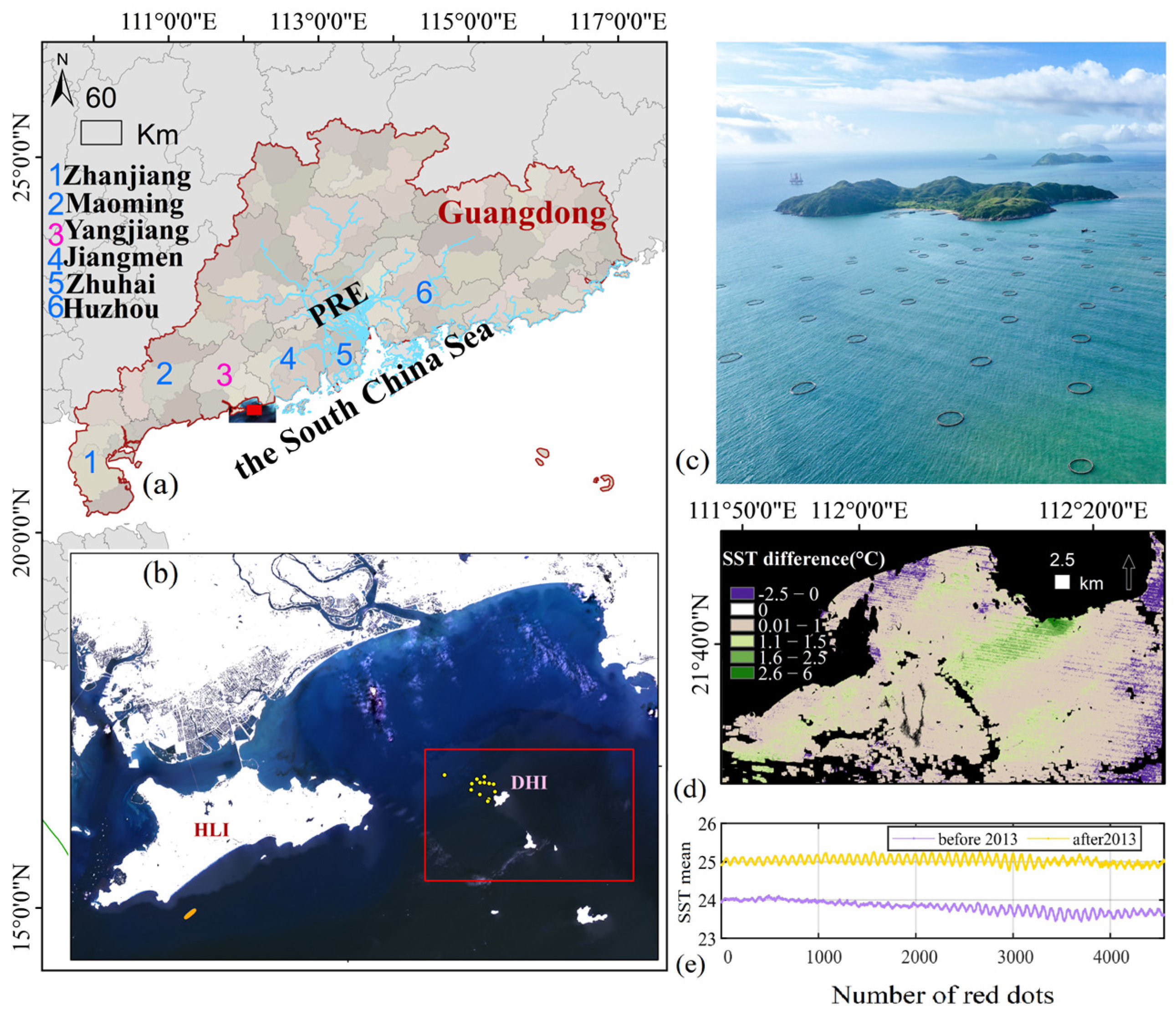
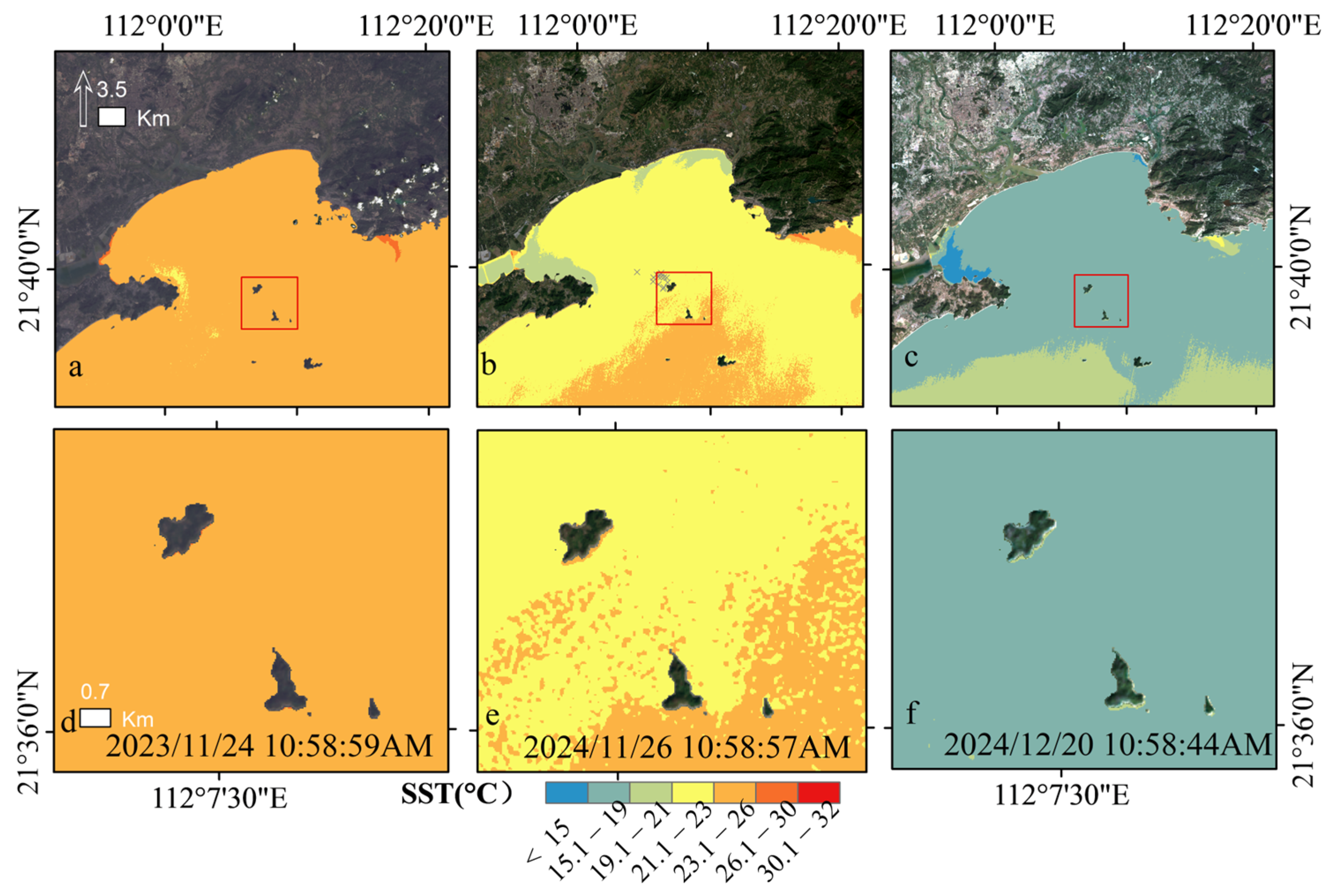
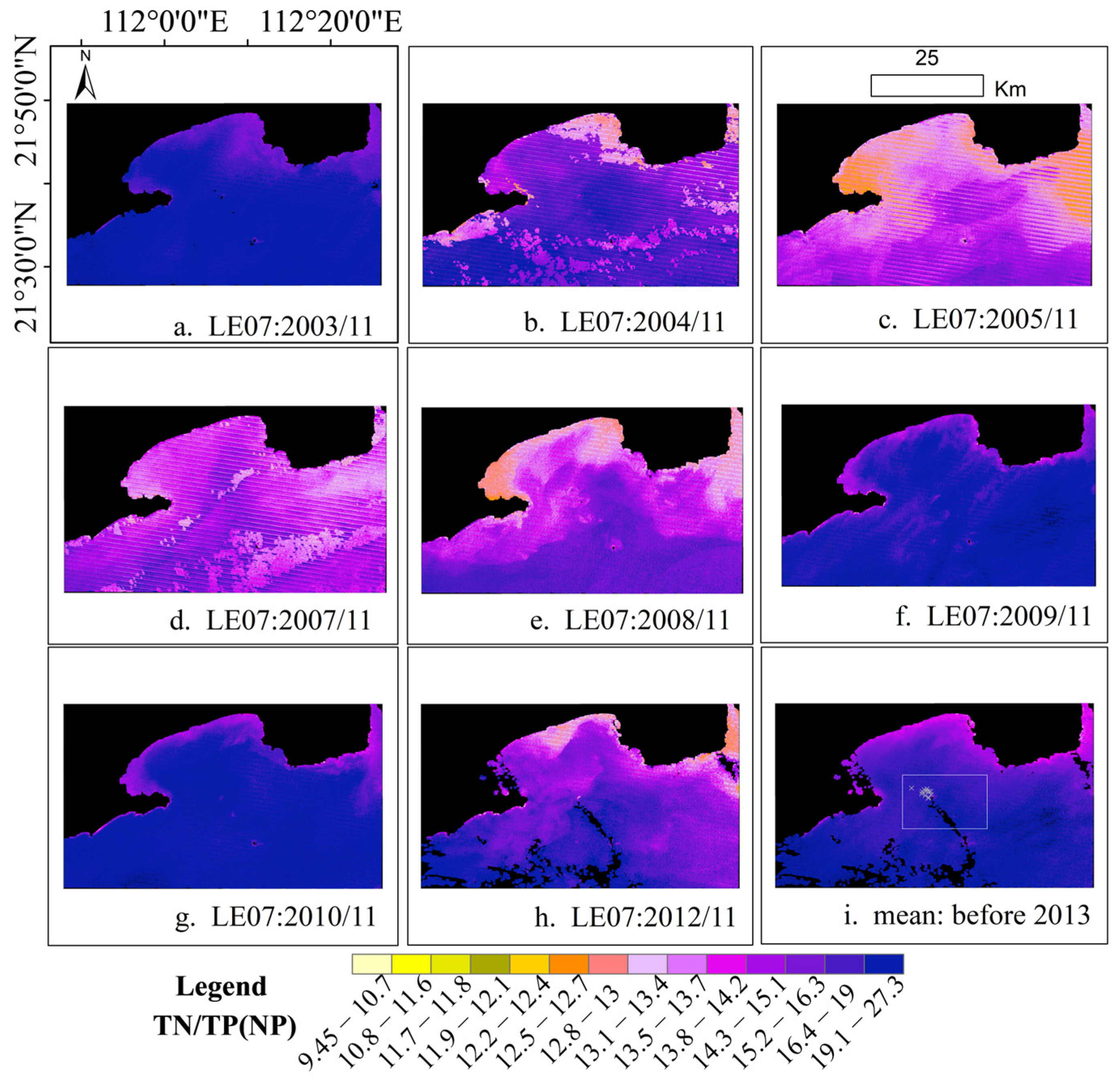

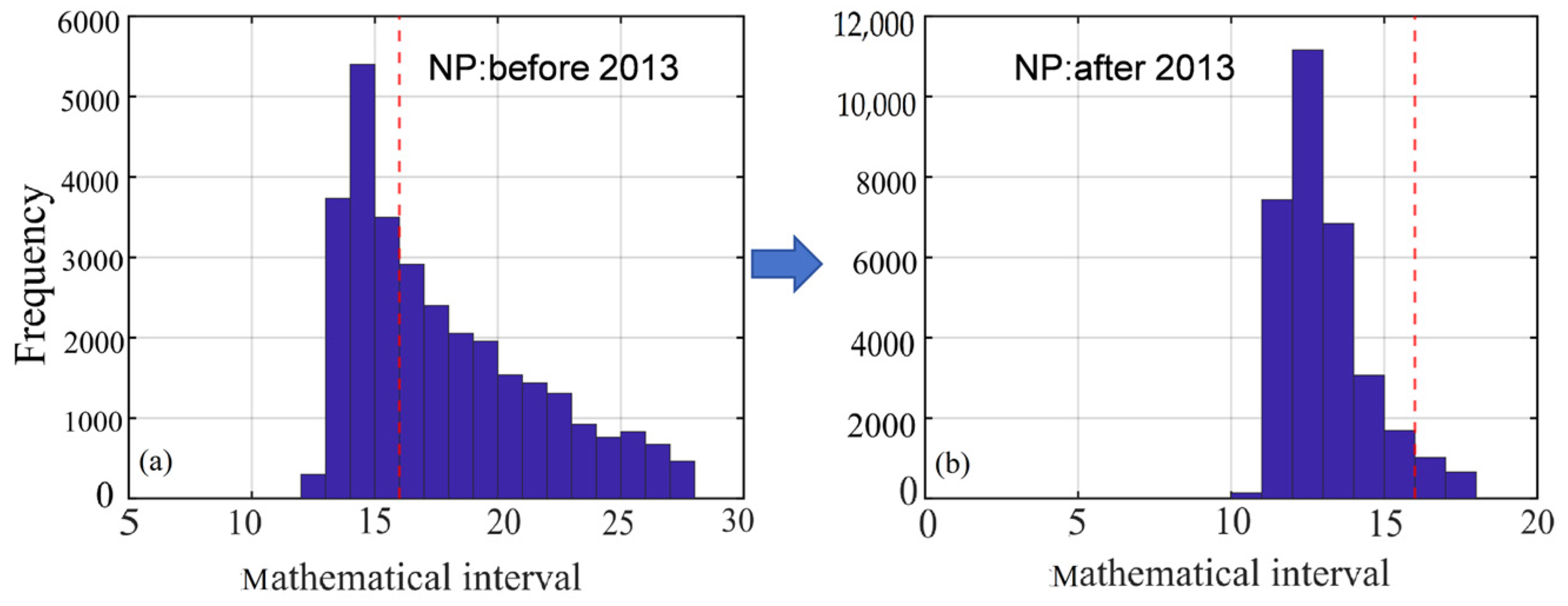
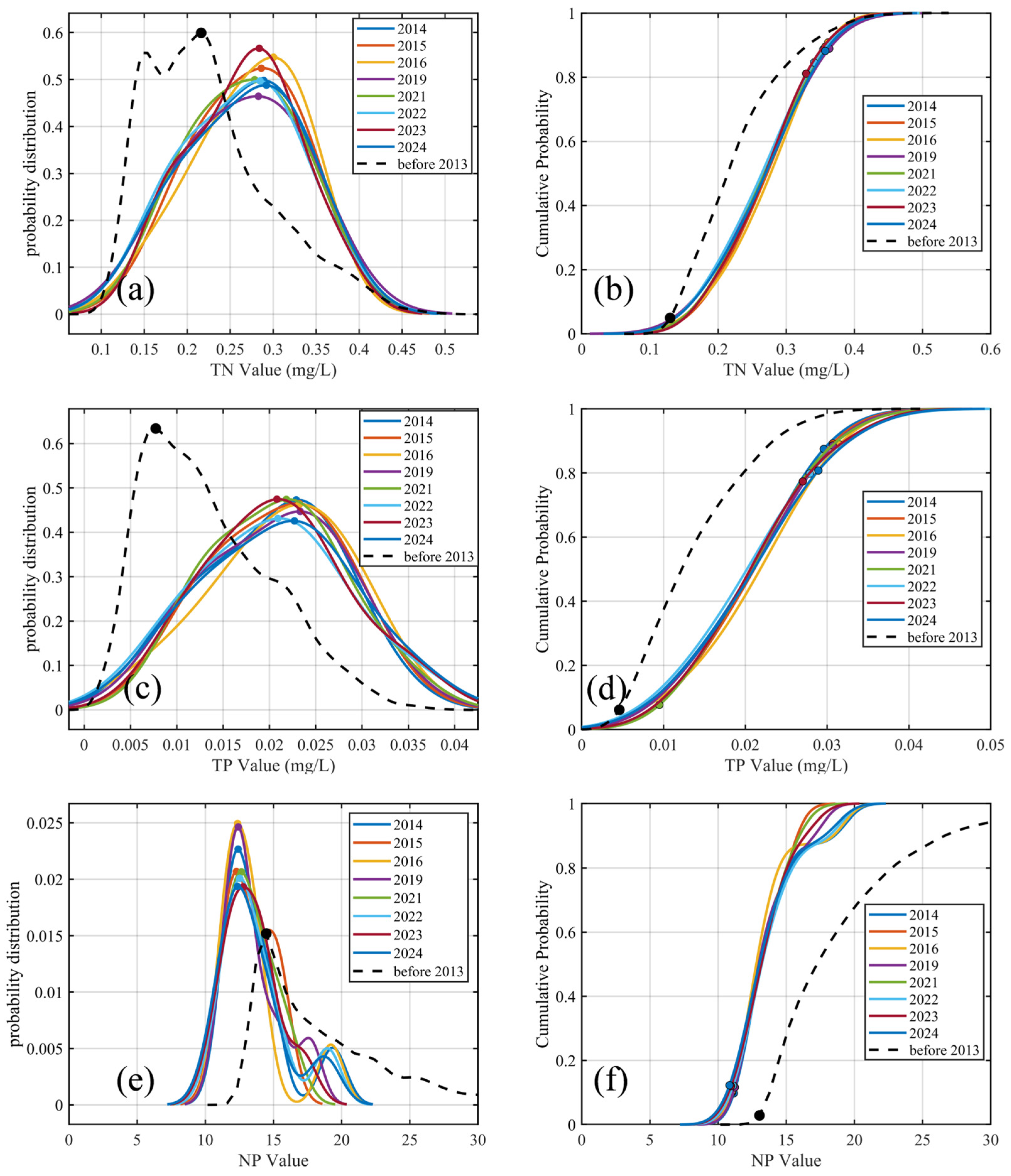
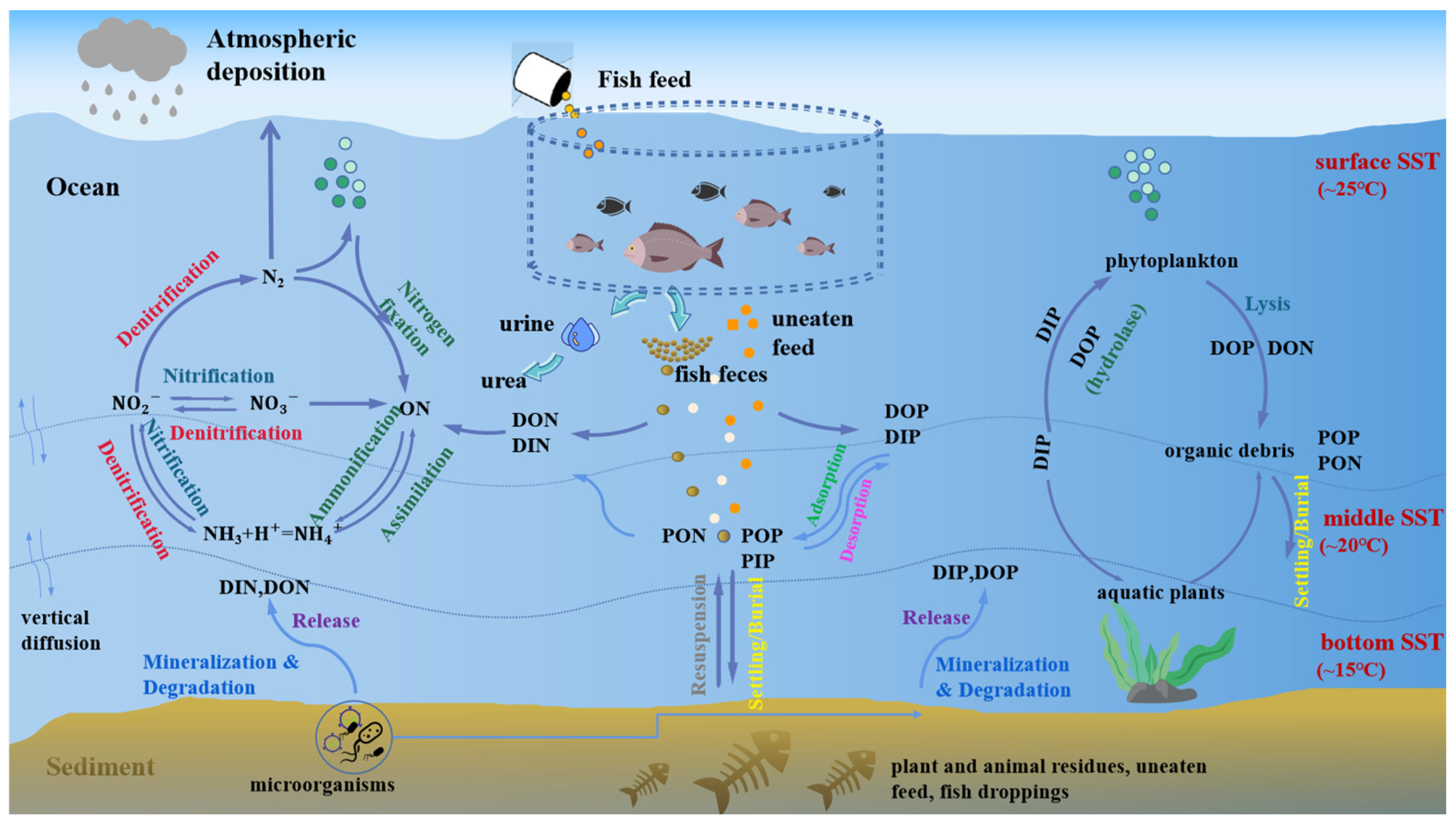
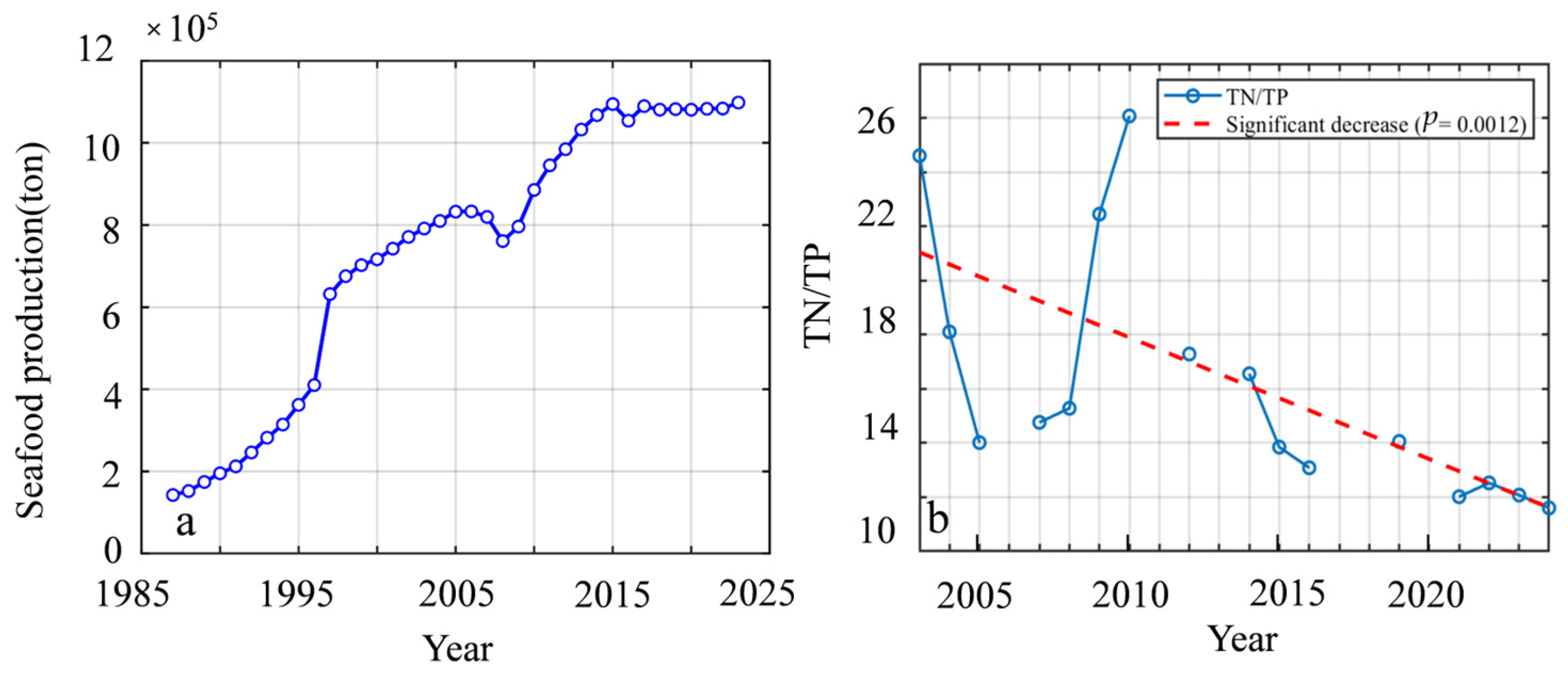
| Data Type | Data Name | Data Source | Time Period | Coverage |
|---|---|---|---|---|
| Satellite Observation | Landsat 5/7/8/9 data | National Aeronautics and Space Administration (NASA) | 1995–2024 | Yangjiang offshore aquaculture area |
| Optical Remote Sensing | Sentinel-2 data | European Space Agency (ESA) | 2019–2024 | Yangjiang offshore aquaculture area |
| Offshore Cage Field Observation | TN (mg/L), TP (mg/L), SST (°C) | CCCC Guangdong-Hong Kong-Macao Greater Bay Area Innovation Research Institute Ltd. | January–April 2024, 23 November 2024 | Yangjiang offshore aquaculture area |
| Stations | X (Longitude/°E) | Y (Latitude/°N) | SST (°C) | TN (mg/L) | TP (mg/L) |
|---|---|---|---|---|---|
| 0 | 112.074 | 21.660 | 22.84 | 0.514 | 0.044 |
| 1 | 112.112 | 21.653 | 23.75 | 0.568 | 0.036 |
| 2 | 112.113 | 21.647 | 23.86 | 0.515 | 0.039 |
| 3 | 112.105 | 21.659 | 23.71 | 0.498 | 0.040 |
| 4 | 112.109 | 21.654 | 23.88 | 0.598 | 0.044 |
| 5 | 112.099 | 21.657 | 23.79 | 0.68 | 0.041 |
| 6 | 112.105 | 21.654 | 23.35 | 0.382 | 0.045 |
| 7 | 112.108 | 21.642 | 23.49 | 0.492 | 0.046 |
| 8 | 112.102 | 21.654 | 23.43 | 0.397 | 0.043 |
| 9 | 112.101 | 21.645 | 22.2 | 0.413 | 0.043 |
| 10 | 112.095 | 21.653 | 22.67 | 0.397 | 0.044 |
| 11 | 112.095 | 21.649 | 23.33 | 0.378 | 0.043 |
| 12 | 112.107 | 21.640 | 23.44 | 0.388 | 0.040 |
| Parameter (Change) | R | p | Correlation |
|---|---|---|---|
| TN_d & SST_d | −0.6513 | 0.0802 | Significant at 0.1 level |
| TP_d & SST_d | −0.6511 | 0.0804 | Significant at 0.1 level |
| N/P_d & SST_d | 0.1229 | 0.7719 | Not significant |
Disclaimer/Publisher’s Note: The statements, opinions and data contained in all publications are solely those of the individual author(s) and contributor(s) and not of MDPI and/or the editor(s). MDPI and/or the editor(s) disclaim responsibility for any injury to people or property resulting from any ideas, methods, instructions or products referred to in the content. |
© 2025 by the authors. Licensee MDPI, Basel, Switzerland. This article is an open access article distributed under the terms and conditions of the Creative Commons Attribution (CC BY) license (https://creativecommons.org/licenses/by/4.0/).
Share and Cite
Zhang, R.; Chu, N.; Yin, K.; Dong, L.; Li, Q.; Liu, H. Satellite-Based Analysis of Nutrient Dynamics in Northern South China Sea Marine Ranching Under the Combined Effects of Climate Warming and Anthropogenic Activities. J. Mar. Sci. Eng. 2025, 13, 1677. https://doi.org/10.3390/jmse13091677
Zhang R, Chu N, Yin K, Dong L, Li Q, Liu H. Satellite-Based Analysis of Nutrient Dynamics in Northern South China Sea Marine Ranching Under the Combined Effects of Climate Warming and Anthropogenic Activities. Journal of Marine Science and Engineering. 2025; 13(9):1677. https://doi.org/10.3390/jmse13091677
Chicago/Turabian StyleZhang, Rui, Nanyang Chu, Kai Yin, Langsheng Dong, Qihang Li, and Huapeng Liu. 2025. "Satellite-Based Analysis of Nutrient Dynamics in Northern South China Sea Marine Ranching Under the Combined Effects of Climate Warming and Anthropogenic Activities" Journal of Marine Science and Engineering 13, no. 9: 1677. https://doi.org/10.3390/jmse13091677
APA StyleZhang, R., Chu, N., Yin, K., Dong, L., Li, Q., & Liu, H. (2025). Satellite-Based Analysis of Nutrient Dynamics in Northern South China Sea Marine Ranching Under the Combined Effects of Climate Warming and Anthropogenic Activities. Journal of Marine Science and Engineering, 13(9), 1677. https://doi.org/10.3390/jmse13091677







